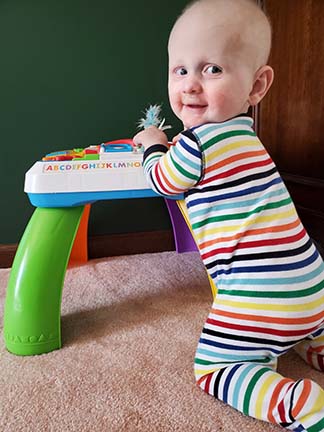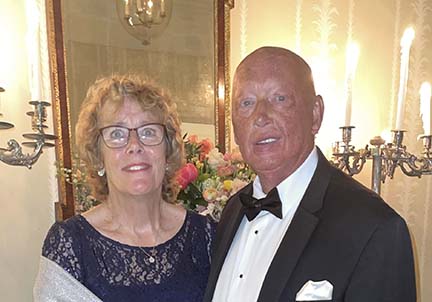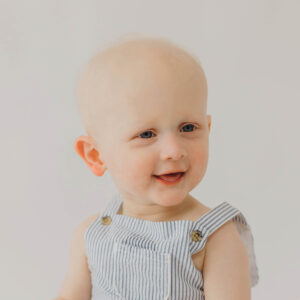Baby Jack is a bundle of energy—standing, scooting and exploring like any curious toddler. But for his family, every little wiggle comes with a bigger question: Is he sweating?
Born with x-linked hypohidrotic ectodermal dysplasia (XLHED), Jack is one of the 10 participants in a groundbreaking prenatal treatment trial, offering hope that he might develop the sweat glands that his grandfather Frank—and generations before him—never had.

So far, the published findings are pending. But if Jack follows in the footsteps of six other boys from a prior study, Trial to Cure, he may sweat normally. For his family, the possibility is powerful.
Frank’s Role in Launching the Research Decades Ago
This moment is especially meaningful for Frank. Not only is he affected by XLHED himself, he played a key role in the very research that led to today’s trial. Frank served on the NFED Board of Directors (BOD) from 1985-2006, many of those years as president.

During his tenure, the Foundation launched the research program in 1986 and approved patient access and funding early studies that helped identify the gene for XLHED. This laid the foundation for the Edelife Clinical Trial decades later, which is currently enrolling patients.
Frank never dreamt that research decisions he and the Board made in the late 1980s had the potential to enable his future grandson to develop sweat glands. He said the Board relied upon the NFED Scientific Advisory Council (SAC) heavily for their input and for them to legitimize the research proposals that were being presented to them.
“To be honest, I was skeptical, but they were endorsed by the SAC, and just the whole concept of being able to make a difference was kind of scary, but also pretty cool. So we did that, and I had no idea of how that would impact me and my grandchild down the road.”

Frank said the BOD and SAC made decisions that not only met families’ immediate needs at the time but that also looked towards the future.
“What we did, as far as parental information or helping the parents and the little ones grow up and realize that, yes, it’s going to impact your life, but you can have a good life. You can be a normal person, whatever that means. Those things were very important at that point in time, and it seemed like that had an immediate, positive impact.

“But, the decisions that were made in the eighties and the early nineties that created a more long-term and more of a life-changing impact for these little babies now – one of them being my own grandson – that’s something! I’m proud of the decisions that we made. I don’t necessarily think that we were aware of the future and the impact that those decisions would have because nobody was. There was no guarantee that anything was going to come about.”
Not Sweating is Not Fun
Frank was the first in the family to get a name for his condition in the summer of 1954 when he was just a baby. Repeated trips to the ER with unexplained fevers would vanish when he entered their air-conditioned rooms. A doctor finally took a biopsy, realized Frank had no sweat glands and diagnosed him with hypohidrotic ectodermal dysplasia. He had uncles and relatives who were also affected but nobody ever connected the dots since the female carriers didn’t show symptoms.
Looking back, Frank said the heat and controlling his body temperature have been the toughest physical challenge about XLHED. That’s why he’s excited that Jack may not have to face those obstacles.
Born in the early 1950s, his family didn’t get air conditioning in their home until he was in high school and his dorm at Saint John’s Military Academy Military School was not air conditioned. His symptoms kept him from following in his father’s footsteps with a military career, even though he had been offered the chance to attend the U.S. Military Academy at West Point.
While his XLHED prevented that dream, Frank didn’t let the condition hold him back in life. He and his siblings (all of whom are affected by XLHED) spent summers visiting their grandpa on a farm where they were expected to do chores until lunch and then could play. He says this taught him early on how to have a strong work ethic and find ways to “get it done.”
His favorite way to cool down would be to soak his T-shirt and then lay on the basement floor. The cold concrete floor would draw the heat out of his body. Or, if outside, he’d wet his shirt, find shade and hope for a good breeze.
He built a successful career, raised a loving family and lives a good life.

A Daughter’s Determination to Help Her Son
Frank’s daughter, Elizabeth, grew up knowing that her dad’s inability to sweat sometimes prevented him from participating in certain activities. When she and her husband, John, began family planning, she read about the research findings that six boys affected by XLHED were now sweating normally after receiving an investigational treatment before birth. When she became pregnant with a boy, she knew she wanted to give her unborn son a chance at developing sweat glands.
“There was never a question of whether or not I would participate in the study. Because, if it works, it works. All those kids in the previous study up to that point, it was helping them sweat. Why wouldn’t you try to improve your son’s life?” – Elizabeth
Elizabeth said that safety testing for the treatment had been done in a previous study on XLHED-affected adults. Researchers found that while the treatment did not improve symptoms since it was given after birth, there were no negative side effects either. These results helped her decision making.
John reached out to Frank for advice. The man who could not imagine what his life would have been like if he could sweat told John he thought it was a good idea.

Elizabeth and John live just 40 minutes from the Edelife clinical site at Washington University in St. Louis, Mo., making participation in the trial more manageable. She said that Dr. Kathy Grange and the treatment team were fantastic and made participation easy. Baby Jack was born in spring of 2024 and has been thriving ever since.
Four Generations Committed to Advancing Science

Elizabeth is not the first in her family to volunteer for XLHED research. Frank contributed to the NFED’s first XLHED studies, providing blood samples and completing surveys. Even Frank’s late mother, Dorothy, wrote to the NFED in the1980s expressing her interest in participating. Like Elizabeth, she, too, was a carrier for XLHED.
Encouraging Other Families to Be Brave

Frank and Elizabeth are united in their message to other families facing XLHED: don’t be afraid to take part in the clinical trial.
“Be brave for the sake of your unborn child. – Frank
“There’s no reason not to participate and put yourself out there”, Frank said. “I’m not aware of any bad things that have come out of it. The fact that the federal government would allow this research to take place gives me some confidence that somebody has looked at it and decided that it meets the criteria to move forward. Be brave, put yourself out there and get her done!”

Elizabeth, who dislikes needles, underwent three amniocentesis procedures for the treatment.
“It was not fun, but you do it,” Elizabeth said. “It takes just a few minutes. It’s more anxiety to psych yourself up for it. And then it just happens. You’re like, that’s it? But, please just do it. We need people because the study’s results are only going to be qualified by the Federal Drug Administration (FDA) if we get to a certain number of people.”
The Edelife Clinical Trial is enrolling 5-10 more people.
A Chance to Change a Child’s Life

Elizabeth says the only real cost of participating in the trial is time.
Learn About EdelifeIf you know you’re a carrier, and you know you’re having a boy, please seriously, consider this. The fact is you know from the pretrial study that all the kids were sweating. You have the opportunity to really change your child’s quality of life. – Elizabeth

Hi, I was born and raised in Vancouver BC Canada. I was diagnosed with EDD when I was 6 yrs old but no specific type. I am a female and unfortunately developed physical symptoms. Lack of hair(sweat glands), lack of adult teeth, nails and skin affected 2yrs behind in both growth at birth and now with reading this article, I believe I have a form of HED. I am now 63yrs old and it”s fantastic there has been a development in helping babies. I have been following NFED for many years. There is nothing in Canada to help others as I have tried to contact the group supposedly in Ontario but not had a reply. NFED, you do great work, keep it up and hopefully babies all over the world will get treatment for HED and other forms of Ecto-dermal Dysplasia.